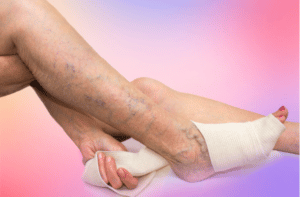
Symptoms of venous insufficiency can include:
- A dull ache or cramping sensation
- Itching or tingling in the legs
- A sensation of heaviness in the legs
- Restless legs syndrome
- Pain that worsens when standing and decreases when the legs are elevated
- Changes in skin color
- Dry, cracked skin above the vein
- Leg ulcers
Venous insufficiency is often referred to as a chronic health condition. This may be so, but there are steps that you can take to better manage your vein health. In so doing, you may decrease the chances of varicose veins getting worse and new problem veins from developing. Some suggested lifestyle modifications include:
Maintain a Healthy Weight
Weight compresses the lower extremities, including the veins and leg muscles. Additionally, we often see a double-whammy factor here in that the patients who are overweight are also patients who are relatively sedentary. These two controllable factors go hand-in-hand, which can actually make it easier to get venous insufficiency under control. To get to a weight that is healthier for your veins, make necessary changes in your diet. For example, cook at home more than you eat out, especially if you tend to consume fast food. It may be necessary to start tracking how many calories you consume each day, a simple task with free calorie counters available online or as smartphone apps. Once you become aware of your average daily intake, you can identify areas in which you can reduce unnecessary calories.
Avoid Salt
The amount of salt, sodium, that you consume correlates with how much your body may retain water. If you eat salty and processed foods every day, your veins may be holding too much fluid and, as a result, are more swollen than they need to be. Reducing sodium intake can be a natural part of managing a healthy weight because, often, the sodium that we are consuming is hidden in processed foods.
Increase Activity Levels
Blood flow out of the legs is helped by the movement of the calf muscles. If you’re not exercising regularly, your calf muscles aren’t compressing the deep veins in your legs as well as they could and need to. It’s easy to step up your activity levels to improve vein health. The number one recommendation that doctors make is to walk more. To support healthy veins, it takes just 30 minutes a day, five days a week. While it is advantageous to walk for a consistent 30 minutes every time, some people have to start in smaller increments. Don’t let this deter you. Anyplace is a good place to start when it comes to getting the body moving. When sitting at a desk or watching television, you can work your calf muscles by sitting with your feet flat on the floor and moving your heels up and down.
Wear Compression Garments
People who undergo treatment for varicose veins often have to wear compression stockings for a few days. Compression garments do the work of the calf muscles. They press on the deep veins in the legs to help move blood up and out. Depending on the severity of your venous insufficiency, your doctor may advise you to wear compression when walking or exercising or to wear them for a set amount of time each day.
Elevate the Legs
Venous insufficiency makes it difficult for blood to naturally exit the veins in the legs. Elevation is a logical and comfortable way to help this motion happen as it should. You can elevate your legs by lying on your back on the floor in front of a sofa or chair. Rest the lower legs on the seat of the chair. Your knees will be bent to about a 90- degree angle. Another way to help move blood out of the legs using elevation is to lie on the floor with your buttocks up to a wall. Rest your extended legs against the wall. In this position, the feet will be up the wall and there will be a 90-degree angle at the hips.
Venous insufficiency may be an ongoing problem if you do not get the treatment and management care you need. We’re here to help. Contact the Vascular Institute of Virginia at 703-763-5224 to schedule a visit at our Woodbridge, Fairfax, or Fredericksburg location.

